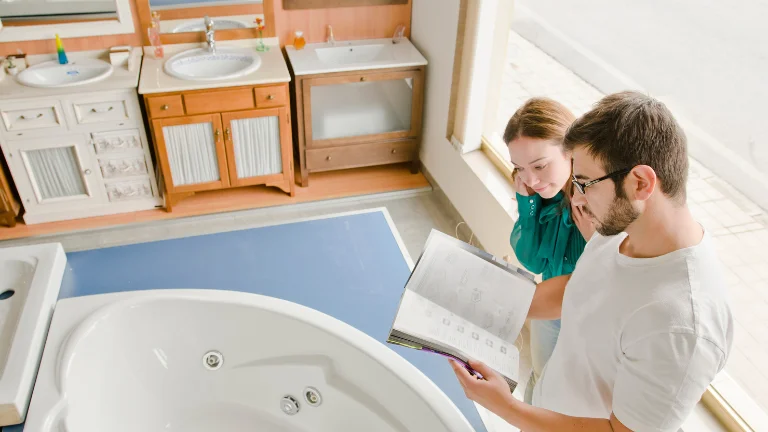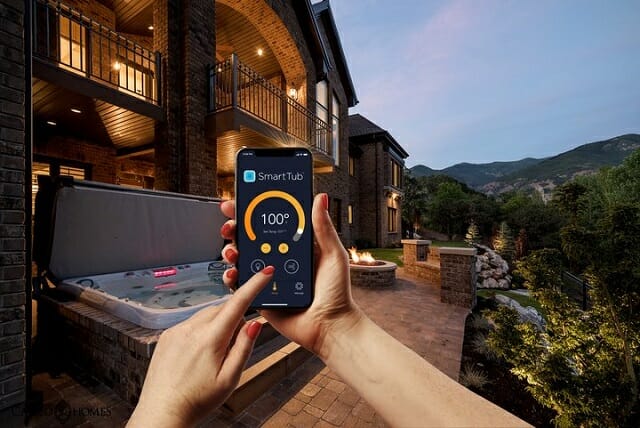Winter Hot Tub Care: Keep Your Spa Safe, Warm, and Running
When the temperature drops and frost hits the ground, one big question bubbles up for hot tub owners: How do I protect my spa during winter without racking up a huge energy bill or causing damage? Winter hot tub care is more than just keeping the water warm, it’s about making sure your tub stays safe, efficient, and ready to use all season long.
Hot tubs lose the most heat through the surface, and a properly fitted insulated cover can reduce that loss by as much as 70 to 75 percent. That’s a major difference in both comfort and cost.
A poorly winterized hot tub can lead to frozen pipes, cracked parts, and costly repairs, with freeze damage repairs averaging $500 to $1,500.
We’ll walk you through the essentials of winterizing your hot tub, so you know exactly when and how to prep it properly.
Still want to enjoy your spa when it’s snowing? We’ve got tips for safely using your hot tub in the winter without turning into an icicle or overheating your energy bills.
Here’s what you’ll find in this guide:
- Safety and comfort tricks for using your tub in cold weather
- Simple ways to prevent your hot tub from freezing overnight
- Key winter maintenance tasks to avoid costly damage
- Power outage protection tips every owner should know
- Winterizing vs. Keeping It Running
- Why Winter Sucks for Hot Tubs
- Is Your Hot Tub at Risk in Winter?
- What is a Hot Tub Freeze Shield? (And Do You Need One?)
- Automatic Freeze Protection: How It Works
- DIY Tips to Keep Your Hot Tub Safe in Winter
- 🛡️ When to Invest in Advanced Hot Tub Protection
- Common Winter Hot Tub Problems and Fixes
- Preparing Your Hot Tub for Winter: A Step-by-Step Guide
- What to Do If Your Hot Tub Freezes
- Energy Efficiency in Cold Weather
- FAQs
Winterizing vs. Keeping It Running
Deciding whether to shut down your hot tub or keep it running through winter comes down to use, climate, and maintenance effort.
Keep It Running
Pros:
- Ready for use anytime
- Prevents freezing with continuous circulation
- No need to re-fill in spring
Cons:
- Higher energy use
- Needs weekly checks
- Risk if there’s a power outage
Tip from Jacuzzi and PDC Spas: Use a quality cover and thermal blanket, and maintain water levels to avoid freeze damage.
Winterize It
Pros:
- No upkeep or energy cost
- Best if you’re away or not using it
Cons:
- Must be done thoroughly to prevent damage
- Can’t use it until spring
Only winterize if temps stay above freezing for part of the day or you’re leaving it unattended for weeks.
Key Winterizing Steps
- Drain water and blow out lines
- Clean shell, filters, and jets
- Remove accessories
- Secure the cover (add a thermal blanket for extra protection)
Done right, both options protect your tub, just pick what fits your winter plans.
Why Winter Sucks for Hot Tubs
Cold’s a Pipe-Buster
Winter’s freezing temps are rough. Water expands 9% when it freezes, and that can crack your hot tub’s pipes, pumps, or shell. Think ice tearing through your spa like a wrecking ball.
Fix it: Drain the tub if you’re not using it, or keep the heater on for regular soaks.
Power Outages Screw You Over
Winter storms knock out power, and no power means no heat. Your hot tub’s freeze protection? Useless. One cold night can turn your spa into a giant ice cube.
Fix it: Get a generator or check your tub after storms. Stay on top of the weather.
Neglect Costs Big
Freeze damage isn’t cheap repairs can run $200 to $2,000. That’s vacation money down the drain for something you could’ve prevented.
Fix it: Use a good cover, insulate well, and don’t skip maintenance.
Energy Bills Skyrocket
Keeping your hot tub warm in winter is like heating your house with a match. Bills can jump 30% if your tub’s not insulated or maintained. Sloppy filters make it worse.
Fix it: Clean filters, check insulation, and get a tight cover to save cash.

Is Your Hot Tub at Risk in Winter?
Freezing Temps? Big Risk
If you live where it’s consistently below freezing, your hot tub’s in danger. One super cold night can wreck it if you’re not ready.
Check: Are winters harsh where you live?
Old or Crappy Insulation
Older or cheap hot tubs often have weak insulation. If your energy bill spikes or the water’s not staying warm, your spa’s not ready for winter.
Check: Does your tub struggle to hold heat?
Power Outages Spell Trouble
Frequent winter storms or power cuts? Bad news. No electricity means no freeze protection, and water can freeze in a day or two.
Check: Does your area lose power often?
Sitting Unused
Not using your hot tub much? Stagnant water in the pipes can freeze fast. Running the jets a bit keeps things moving.
Check: Is your tub sitting idle for weeks?
Warning Signs to Watch
- Frozen Pipes: Weird pump noises or low water flow? Could be ice.
- Cracks: Look for damage on the shell or equipment.
- Error Codes: Your hot tub might flash warnings if it’s too cold.
Quick Checklist
- Harsh winters where you live?
- Shoddy insulation?
- History of power outages?
- Tub unused for long stretches?
- Seeing cracks, odd noises, or error codes?
Any “yes” means you’re hot tubs at risk. Time to winterize!
What is a Hot Tub Freeze Shield? (And Do You Need One?)
To protect your hot tub from freezing temperatures, a freeze shield is a feature that is either built-in or added-on. Consider it as the personal winter bodyguard of your spa.
During cold weather, the freeze shield activates, utilizing a mix of sensors, heaters, and pumps to keep water flowing and prevent ice from forming in the pipes.

How Does It Work?
- Temperature Sensors: These detect when the water or air temperature drops to a dangerous level (usually around 40°F or lower).
- Automatic Activation: Once triggered, the system turns on the pump or heater to circulate warm water and prevent freezing.
- Peace of Mind: Even if you’re not home, your hot tub stays protected.
Do You Need a Freeze Shield?
Not every hot tub owner needs a freeze shield, but here’s when it’s worth considering:
- You Live in a Cold Climate: If winter in your area is brutal, a freeze shield is a no-brainer.
- You Travel Frequently: If you’re away from home during winter, this feature ensures your spa stays safe.
- Your Hot Tub is Exposed: Spas located outdoors or in unheated areas are more vulnerable to freezing.
- You Want to Avoid Repairs: Spending a little now on a freeze shield can save you hundreds (or thousands) in repair costs later.
The Pros and Cons
| Pros | Cons |
|---|---|
| Prevents costly freeze damage | Adds to the upfront cost of the spa |
| Works automatically, even if you’re not home | May increase energy usage slightly |
| Extends the lifespan of your hot tub | Not all models come with this feature |
Automatic Freeze Protection: How It Works
Automatic freeze protection is a must-have for those living in cold climates or who want to avoid the hassle of winter hot tub maintenance. It’s similar to insurance for your spa, you hope it won’t be necessary, but you’ll be grateful it’s there when it’s needed.
The Basics of Automatic Freeze Protection
A system that detects freezing conditions and takes action to prevent damage is known as automatic freeze protection in many modern hot tubs. It is designed to activate when temperatures drop, guaranteeing the safety of your spa even when you’re not paying attention.
How It Works: A Step-by-Step Breakdown
- Temperature Sensors:
- The system uses sensors to monitor both the water temperature and the ambient air temperature.
- If either drops to a critical level (usually around 40°F or lower), the system activates.
- Automatic Activation:
- Once triggered, the system turns on the circulation pump to keep water moving through the pipes.
- In some models, a small heater may also activate to maintain a safe water temperature.
- Continuous Monitoring:
- The system doesn’t just turn on and off—it constantly monitors conditions.
- If temperatures rise, it shuts down to save energy. If they drop again, it kicks back into action.
- Peace of Mind:
- Whether you’re at work, on vacation, or just cozy inside, your hot tub is protected.
Why It’s a Game-Changer
- No Manual Intervention: Forget about setting timers or checking the weather forecast. The system does all the work for you.
- Prevents Costly Damage: By keeping water moving and preventing ice formation, it saves you from expensive repairs.
- Energy Efficient: Modern systems are designed to use minimal energy, so you’re not stuck with sky-high bills.
What Happens If the Power Goes Out?
Here’s the catch: automatic freeze protection relies on electricity. If your area is prone to power outages, you’ll need a backup plan (like a battery-powered pump or generator) to keep your spa safe.
DIY Tips to Keep Your Hot Tub Safe in Winter
Winter doesn’t have to be a nightmare for your hot tub. Even if you don’t have fancy features like automatic freeze protection, there’s plenty you can do to keep your spa safe and sound. Here are some easy, budget-friendly DIY tips to help you outsmart the cold.
1. Insulate Like a Pro
- Cover Up: A high-quality, insulated hot tub cover is your first line of defense. Make sure it fits snugly and doesn’t have any gaps.
- Wrap the Pipes: Use foam pipe insulation to protect exposed plumbing. It’s cheap, easy to install, and can make a huge difference.
- Add a Thermal Blanket: Floating thermal blankets sit on the water’s surface and help retain heat, reducing energy costs and preventing freezing.
2. Keep the Water Moving
- Run the Jets: If temperatures drop, turn on the jets for 10-15 minutes every few hours to keep water circulating.
- Use a Small Pump: If you’re worried about power outages, a battery-powered backup pump can keep water moving even when the electricity is out.
3. Adjust the Thermostat
- Set It Slightly Higher: Bump up the temperature by a few degrees during extreme cold snaps. This gives your hot tub a better chance of staying above freezing.
- Don’t Turn It Off: Even if you’re not using the hot tub, keep it running. Turning it off increases the risk of freezing.
4. Prepare for Power Outages
- Invest in a Generator: A small portable generator can keep your hot tub running during outages.
- Drain the Tub (If Necessary): If you know a long outage is coming and can’t use a generator, draining the tub might be your best bet. Just make sure to follow the manufacturer’s instructions.
5. Check for Leaks and Weak Spots
- Inspect Regularly: Look for cracks, leaks, or worn-out seals that could let cold air in.
- Seal the Gaps: Use weatherproofing tape or foam to seal any gaps around the hot tub cabinet or cover.
6. Use Antifreeze (Carefully!)
- Non-Toxic Formula: If you need to winterize your hot tub, use a propylene glycol-based antifreeze specifically designed for spas.
- Follow Instructions: Never pour antifreeze directly into the water. Instead, use it to flush the plumbing system if you’re shutting down the tub for the season.
7. Keep an Eye on the Weather
- Stay Alert: Monitor forecasts for extreme cold or storms. If a deep freeze is coming, take extra precautions like running the jets more frequently.
- Clear Snow and Ice: Brush off snow and remove ice buildup around the cover to prevent damage and improve insulation.
Quick DIY Checklist
- Insulate pipes and cover gaps.
- Run the jets regularly.
- Adjust the thermostat slightly higher.
- Have a backup plan for power outages.
- Inspect for leaks and weak spots.
- Use antifreeze only if necessary.
- Monitor the weather and clear snow.
🛡️ When to Invest in Advanced Hot Tub Protection
Protect your investment and enjoy peace of mind during harsh winters with these advanced protection solutions.
5 Signs You Need Advanced Protection
Harsh Winter Climate
“Arctic tundra” winters require automatic freeze protection or dedicated freeze shields.
Frequent Travel
Automatic systems protect your spa when you’re away from home.
Older Hot Tub Models
Lacking modern insulation? Advanced systems can extend your spa’s life.
Previous Freeze Damage
Prevent repeat incidents after experiencing frozen pipes or cracked pumps.
Save Time & Effort
Reduce winter maintenance chores with automated protection systems.
Protection System Options
| System | Best For |
|---|---|
| Automatic Freeze Protection | Cold climate owners who want hands-off protection |
| Freeze Shield | Older hot tubs or areas with frequent power outages |
| Battery Backup Pumps | Storm-prone areas or for added peace of mind |
| Smart Monitoring Systems | Tech-savvy owners wanting remote alerts/control |
💰 Cost-Benefit Analysis
Freeze Damage Repairs
$200-$2,000
Average cost for fixing frozen pipes/pumps
Protection Systems
$100-$500
One-time investment for prevention
Smart protection pays for itself by avoiding just one repair incident!
💡 Don’t wait for damage to happen – proactive protection saves money and stress in the long run.
Check out What to Wear in a Hot Tub in Winter
Common Winter Hot Tub Problems and Fixes
Winter can throw some serious curveballs at your hot tub. Here’s a quick guide to the most common issues—and how to tackle them:
1. Frozen Pipes
- Problem: Water stops flowing, or you hear strange noises from the pump.
- Fix: Use a hairdryer or heat tape to thaw pipes gently. Never use an open flame!
2. Pump or Heater Failure
- Problem: The pump won’t turn on, or the water isn’t heating.
- Fix: Check for error codes, reset the system, or call a professional if needed.
3. Ice Buildup on the Cover
- Problem: Heavy ice makes it hard to open or damages the cover.
- Fix: Use a soft broom to remove snow and gently melt ice with warm water.
4. Water Quality Issues
- Problem: Cloudy water or unusual odors due to cold weather.
- Fix: Test and balance chemicals regularly, and clean filters more often.
5. Power Outages
- Problem: No electricity means no heat or circulation.
- Fix: Use a generator or battery backup pump to keep water moving.
Preparing Your Hot Tub for Winter: A Step-by-Step Guide
Get your hot tub winter-ready with these quick steps:
- Clean and Balance the Water:
- Drain, clean, and refill the tub. Test and adjust pH, alkalinity, and sanitizer levels.
- Inspect the Cover:
- Check for cracks or wear. Replace if necessary to ensure proper insulation.
- Protect the Pipes:
- Insulate exposed plumbing with foam sleeves or heat tape.
- Set Up Freeze Protection:
- Enable automatic freeze protection or install a backup pump for power outages.
- Run the Jets Regularly:
- Keep water moving to prevent freezing, especially during cold snaps.
- Clear Snow and Ice:
- Brush off snow and remove ice buildup around the cover and equipment.
What to Do If Your Hot Tub Freezes
If your hot tub freezes, don’t panic. Here’s how to handle it:
- Turn Off Power:
- Shut off the hot tub to prevent damage to the pump or heater.
- Thaw Gently:
- Use a hairdryer, heat lamp, or warm towels to slowly thaw frozen pipes. Avoid open flames or boiling water.
- Check for Damage:
- Inspect pipes, pumps, and the shell for cracks or leaks once thawed.
- Call a Pro if Needed:
- If you’re unsure or find damage, contact a professional for repairs.
- Prevent Future Freezing:
- Add insulation, enable freeze protection, or use a backup pump to avoid a repeat.
Energy Efficiency in Cold Weather
Winter can spike your hot tub’s energy use, but these tips can help you save:
- Upgrade the Cover:
- A well-insulated cover reduces heat loss.
- Lower the Temperature:
- Drop the thermostat by a few degrees when not in use (but keep it above freezing).
- Use a Thermal Blanket:
- Floating blankets add an extra layer of insulation.
- Seal Gaps:
- Weatherproof the cabinet to keep cold air out.
- Maintain the System:
- Clean filters and check for leaks to ensure efficient operation.












